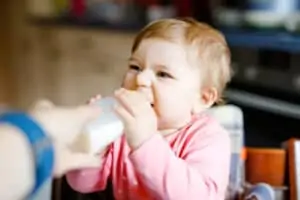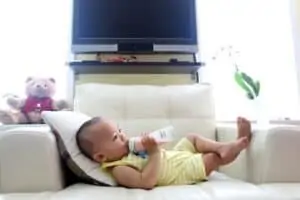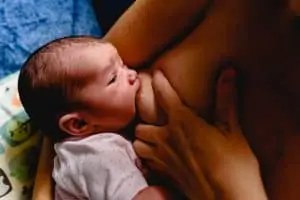Most babies prefer to drink their formula or breastmilk warm, but keeping a baby bottle warmer is difficult at times. Parents struggle to warm up bottles in the middle of the night or while on-the-go with their child.
Well-meaning grandparents might tell you to use the microwave, but doctors no longer recommend that parents heat formula or breastmilk in a microwave. Doing so increases the risk of overheating the milk, burning your baby’s mouth, and decreasing nutritional value.
So, how are parents supposed to warm up a baby’s bottle?
I remember feeling the same confusion as you when I had my first child. Here are some practical solutions and information you need to know about safely heating and warming a baby’s bottle.
Are You Supposed to Warm Up Baby Bottles?
Warming up your baby’s bottle is a personal preference. Some babies prefer to drink warm milk rather than cold milk. It’s not uncommon for babies to object to a bottle if it’s cold.
Breast-fed babies who are fed bottles, as well as nursing, often prefer a warmed-up bottle. This is because they are used to the warm milk that comes from their mother’s breast. Switching to a bottle is much easier when they have warmed up milk rather than cold.
Many formula-fed babies are comfortable with cold milk, especially if that’s all they have been given from the start. However, it’s not uncommon for a baby to prefer warm milk; warm milk calms infants.
How to Heat Up a Bottle of Breastmilk
Parents have to be careful when they heat a bottle of breastmilk. If you heat up a bottle of breastmilk too high, it leads to the degradation of breastmilk nutrients. You should never heat breastmilk above 104°F; at this point, the nutritional value decreases.
The best way to warm a bottle of breastmilk is to use warm water. Fill a cup or bowl with warm water and place the bottle inside of the bowl or cup. Alternatively, hold it in the bottle or bag of breastmilk underneath running water.
TIP: Make sure the warm water is at the same level as the milk in the bottle or bag for proper heating.
Make sure to continue to swirl the bottle around, spreading in the warm milk. This helps to eliminate any hot spots in the milk and helps spread it evenly. Hot spots are dangerous; babies burn their mouths on these spots of milk.
Using a bottle warmer for breastmilk is an option as well. Parents need to do their research and select the best one. Look for bottle warmers that use the water bath warming technique rather than steam bathing.
Steam bathing is quicker than water bathing. However, it all evenly hits the milk, leading to hotspots and overheating of the milk. The water bath method swirls warmed milk around the bottle, gradually heating it.
No matter if you heat breastmilk in a bowl of warm water or a bottle warmer, you should heat breastmilk to no more than 99°F. Breastmilk is best served at body temperature; this is the temperature that your baby feels most comfortable drinking and eliminates any risk of burning his mouth.
Can You Leave a Bottle Warmer on All Night?
Absolutely not. Remember, a bottle warmer is an electrical device meant to be used and then turned off. Leaving a bottle warmer on all night long increases the risk of fire.
It’s not worth it.
How Do You Prepare Bottles for Night Feeds?
Heating bottles in the middle of the night is so stressful. Your baby is screaming and starving, and you’re struggling to heat a bottle and stay sane while being exhausted.
That’s a recipe for disaster.
Thankfully, there are a few things that you can do to help prepare bottles for night feeding and make your life a little easier.
Set Up Everything at Night
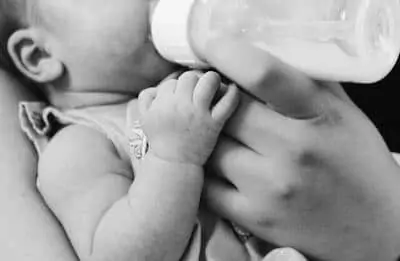
Being prepared as a parent is key. Before you head to bed, set up everything that you’re going to need for night feedings. Keep all of those items close to where your baby will be at night; some parents prefer to heat milk bottles in their kitchen. That’s a personal preference.
Gather all of your supplies, such as:
- Clean bottles
- Bottled water
- Bottle warmer
- Insulated bag
- Burp cloths
I prefer to make bottles in my bedroom or the baby’s bedroom, depending on their age. We room-share for a minimum of six months, so we are heating bottles in our bedroom a lot of the time.
Leave Breastmilk at Room Temp
Many breastfeeding mothers need a break at night, so if your partner is going to give a bottle or if you’re pumping and feeding it in the middle of the night, you need to know how to heat bottles as well.
You can safely leave breastmilk at room temperature for six hours. Pump right before you go to bed, and leave the bottle sitting on your nightstand. Your partner can grab the bottle and take the baby out to feed, leaving you to sleep longer.
Some babies don’t like room-temperature breastmilk, and that’s ok. Warming up room temperature breastmilk is much faster than warming up refrigerated temperature milk. All you have to do is run it under warm water for a few minutes, and it will be good to go.
Use Warm Water
Some parents feel comfortable mixing formula with warm milk. Make sure that you check the temperature of the water before you mix the formula with it. Accidentally easing too hot of water will burn your baby.
Alternatively, fill a cup or bowl with warm water and let the bottle sit in that until it warms up. Some prefer to run the bottle under running water; that’s entirely up to you.
Try a Bottle Warmer
Typically the fastest way to heat a bottle is by using a bottle warmer. You can keep a bottle warmer beside your bed and, after mixing the formula, stick the bottle in the warmer and let it do its job.
While you’re waiting for the milk to be finished, change your baby’s diaper and get ready for feeding time.
If you’re looking for some breast-shaped bottles for feeding, take a look here.
There are some considerations that you should think about when using a bottle warmer.
- Bottle warmers often overheat the milk, so make sure you know how to monitor the temperature.
- Continuously swirl the milk to eliminate hot spots.
- Check the temperature of the milk on your skin before feeding. It’s best to keep formula no more than 100°F, but I prefer 99°F to eliminate any chance of burning.
How to Heat Up a Bottle of Formula
Heating a bottle of formula is just like heating a bottle of breastmilk. The most significant difference is that you have one extra option: using warm water to warm up a bottle of milk.
Let’s take a look at the three ways that you can heat your baby’s bottle of formula.
Use Warm Water
If you have a sink nearby, there’s no need to worry about heating a bottle of formula. Fill your baby’s bottle with warm water from the tap and mix the formula.
Some parents are concerned about the purity of the water that comes from their kitchen sink. That’s a common concern, so don’t feel bad.
Here’s the solution:
To fix this problem, boil some water on the kitchen stove for one minute. Double-check the temperature and let it cool down until it’s 98.6°F and use this water to fill your baby’s bottle.
Heat in a Bowl of Warm Water
One of the most proven safest ways to heat a bottle of formula is to use a bowl of warm water. Heat water on the stove, in the microwave, or use warm but not hot water from the tap. Put this water into a bowl, place the bottle into the bowl, and make sure that the water level lines up with the milk level in the bottle.
Swirl the bottle around several times. Doing this helps to distribute the warmed milk throughout the bottle, heating the milk more evenly.
Use a Bottle Warmer
The last way that you can heat a bottle of formula is by using a bottle warmer. Bottle warmers are convenient for parents, especially in the middle of the night when you are half asleep.
There are two different types of bottle warmers that parents can buy.
- The first type is steam bottle warmers, and as the name suggests, these warmers use steam to heat the milk inside the bottles.
- The second type of bottle warmers is called water bath warmers. These warmers use circulating warm water that flows around the bottle to heat the milk rather than doing so quickly gradually.
No matter what type of bottle warmer you select, you have to make sure that the milk does not increase to a dangerous temperature for your baby. Experts typically recommend that formula is heated up to a temperature of 99°F. This is safe for your baby, and you don’t have to worry about their mouth burning.
FAQs about Keeping Your Baby Bottle Warm
Here are some of the common concerns parents have when heating baby bottles.
How to Keep Baby Bottle Warm at Night?
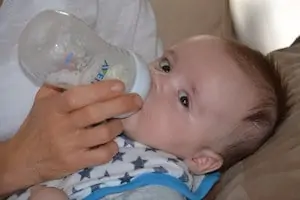
Many parents want to know how they can keep their baby’s bottle warm at night. The problem is that you should never keep a bottle warmer than two hours because it increases the risk of bacteria entering the milk. So, the longest that you should leave milk warm at night is two hours. At some point, you will have to warm your baby’s bottle.
One of the easiest ways to keep a bottle warm at night is to leave it in the bottle warmer. Make sure you read your bottle warmers instructions. Most say that you can safely leave the bottle in the warmer for up to two hours, but that is the longest you can leave it there.
Some warmers have timers, so if your baby is on a predictable schedule, program the heating ahead of time.
Unfortunately, it’s not safe to try to keep your baby’s bottle warm for any longer than two hours at night.
How to Warm Baby Bottle on the Go?
If your baby refuses to drink a cold bottle of milk, you’ll have to figure out heating baby bottles on the go. Most parents don’t stay home all day, every day with their child, so this is an issue that you have to figure out.
Don’t worry; I have a few suggestions that should make this easier for you.
Ask for Warm Water at Restaurant
If you’re heading to a restaurant or cafe, ask the server to give you a glass of warm water. It’s free; it’s the same as a glass of regular water, but it’s warm. This is one of the simplest ways to warm a bottle on the go without needing to bring anything extra with you.
Keep Warm Water in a Thermos
If you aren’t heading to a restaurant or cafe that day, the following solution is to bring a thermos with you and stick warm water in it before you leave your house. A good thermos keeps water warm for up to 24 hours, so it will work for a day of shopping.
You have to think about how many bottles your baby will need while you’ll be gone for that day and plan accordingly. That might mean you need to have more than one thermos or buy a thermos that is large enough to accommodate all of the water that your baby needs for this trip.
Buy a Portable Bottle Warmer
If you live an on-the-go lifestyle, buying a portable baby warm bottle warmer is a practical solution. A portable bottle warmer plugs into your car, allowing you to warm bottles wherever you go.
Use an Insulated Bag
Most people use insulated bags to keep food products cold, but insulated bags keep food warm. Unless you know with certainty that your baby will drink a prepared bottle of formula within two hours, it’s best to use the insulated bag to store warm water in the bottles.
Once your baby is hungry, pour the formula into the warm water in the bottle.
How Long Can You Keep a Baby Bottle Warm?
Parents should only keep a baby bottle warm for one to two hours at most. This sounds inconvenient because, in theory, you could heat several bottles to prepare for night feedings. However, heated milk is a breeding ground for bacteria, so never let your baby drink warmed milk that was heated longer than one to two hours previously.
I stick to the one-hour rule to be extra safe.
Final Thoughts
Keeping your baby’s bottle warm isn’t complicated. The three safest methods are to use a bowl of warm water, a bottle warmer, or use warm water. Any of these options will safely bring your baby’s milk to a comfortable temperature.
Hey, this is Linda. My biggest accomplishment in life is being a mother of four children. Their current ages range from almost ten years old down to 20 months old.
I’m passionate about writing parenting articles because I understand so well all of the problems and trials you face as a parent. From breastfeeding woes to budgeting problems and behavior problems, along with everything in between, chances are I’ve faced it over the last ten years. Read more about Linda here.

